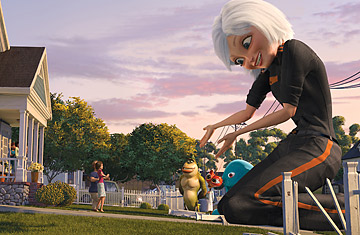
Monsters vs. Aliens
(2 of 2)
Why Not? Here's Why Not
Not since the Bwana Devil days has the industry made such a concerted push for 3-D as a standard movie-watching process. The big question remains: Can the format overcome its carny tincture and become as universally accepted as wide-screen has? The eternal kid in this critic thinks that'd be pretty darn cool; but the Luddite in me has his doubts. Here are three reasons for informed skepticism:
Glasses. We're almost 60 years into the era of showing 3-D in theaters, and you still have to take an eye test to see the movies. Putting on glasses, even the Ray-Ban type now handed out in theaters, does not remove barriers to the appreciation of movies (as director Peter Jackson insists); it is a barrier. Imagine the popular resistance to the first talkies if audiences had to don headsets to hear Al Jolson sing "Swanee." What would the odds on the success of three-strip Technicolor have been if people had to wear specs to see Gone With the Wind or The Wizard of Oz, or the 99% of movies now shown in color? The history of mass entertainment is to make consumption easier, not harder. Until we're in the post-goggles stage of 3-D, the format will be less a dominant form of movie-watching than a theme-park attraction. (See the 50 best inventions of 2008.)
Genres. Would 3-D be a help or a hindrance to more intimate films — to the buddy comedies that are among the most reliable of Hollywood moneymakers, or to those prestige dramas, the high-minded equivalent of TV movies, that keep getting nominated for the Best Picture Oscar? These films don't want to establish a hyper-reality, just a familiar reality that brings the viewer immediately into the lives of their characters. Paul Blart, or the kids from Slumdog Millionaire, would not have benefitted from the in-your-lap urgency of 3-D.
Home Viewing. The 3-D wave of the '50s was meant to lure people away from their TV sets for a unique theatrical experience. But now, the home market — DVD and pay-cable — is where most people see most of their films, and where Hollywood makes much more money than it gets from theaters. Where's the inevitability factor in a format that can't yet be duplicated at home? Even Jeffrey Katzenberg acknowledges that 3-D won't be a major factor in home viewing for quite some time. And he's talking only about DVDs. What about pay-cable? How would HBO show the 3-D version of Monsters vs Aliens — on a separate, 3-D-only channel, with glasses that came with your cable bill?
The business model behind the new 3-D push is simple enough: the movies cost only a little more to make than flat films, while the ticket price is about 25% higher in 3-D theaters. (I sprang $15 to see My Bloody Valentine in Manhattan.) As a rabid movie watcher, I'm not immune to the pleasures 3-D can bring to certain genres. It's an advance in visual appeal similar to, but not greater than, Blu-ray. Which is to say, a difference in degree, not in kind. And with Blu-ray, you don't need the damn glasses.
